Horse News
Member
How Much Are Hay Bales?
Trying to find the perfect bale of hay can sometimes feel like trying to find a needle in a ‘haystack.’ The best hay is cut at exactly the right time, dried quickly to reduce moisture content, contains no mold, smells fresh, and is bright green in color. Sadly, not all hay bales are created equally, and some provide considerably less nutrition than others.
Hay bales come in various shapes and sizes, and can contain a variety of different grasses. Everything from grass type to cutting to quality dictates the bale’s price tag. It’s important to understand your horse’s nutritional needs before shopping for hay. How much you can expect to spend on a hay bale can fluctuate significantly according to location, time of year, demand, and quality.
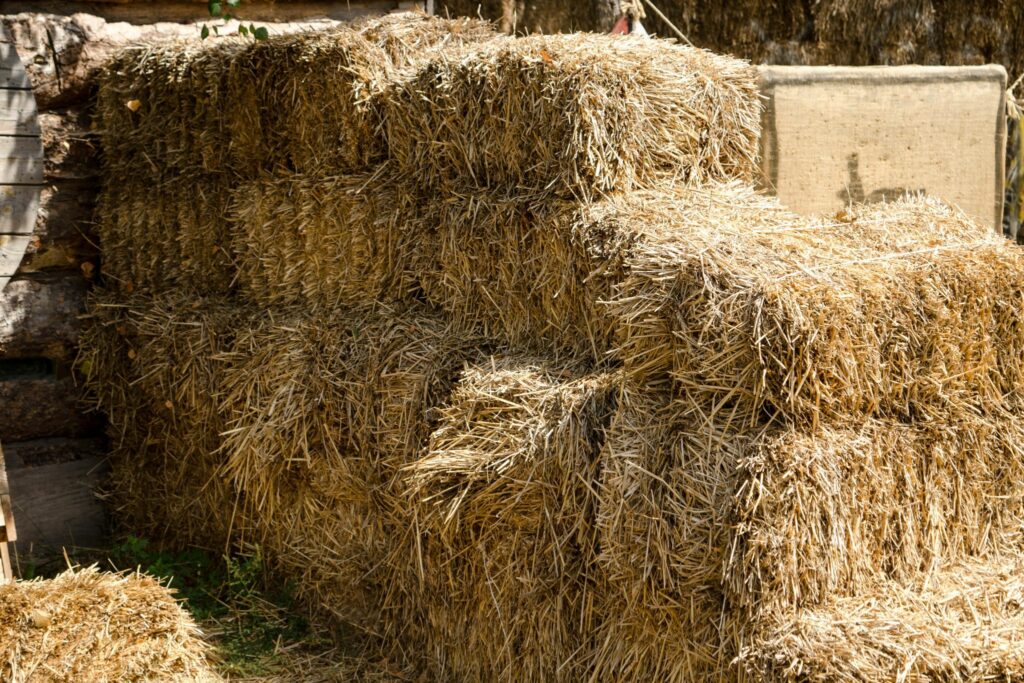
Source: Canva
The Hay Bale: Fact vs. Fiction
Many people are convinced that alfalfa is the best hay for horses, and in many circumstances it is. High in protein and easily digestible, alfalfa is great for horses with elevated energy requirements. For your average adult horse, however, grass hay may be a better, and (sometimes) cheaper option.
Similarly, some horse owners believe that large round hay bales “contain diseases such as botulism,” because they associate it with a higher moisture content. This isn’t true, however.
Large bales are baled at the same moisture level as small bales, making them perfectly safe for horses to eat.
These are just a couple of persistent myths regarding hay bales and roughage for horses. We’ll address a few more during the course of this article, while also exploring the different types of and bale sizes available, along with their current prices.
Hay Bale Sizes
You can buy hay in several different sized bales. Your barn setup and the equipment available to handle hay will partially dictate bale size.
Like most things, “buying in bulk” will typically save you money. This translates to larger bales usually being the most cost-effective, but also the most difficult to store.
Round Bales
Round hay bales come in a couple of sizes, with the largest measuring 6’ wide by 8’ tall and weighing between 900 and 1,500 lb, depending on the type of grass.
The standard round bale is slightly smaller, measuring around 4’ in width and standing 5’ feet high.
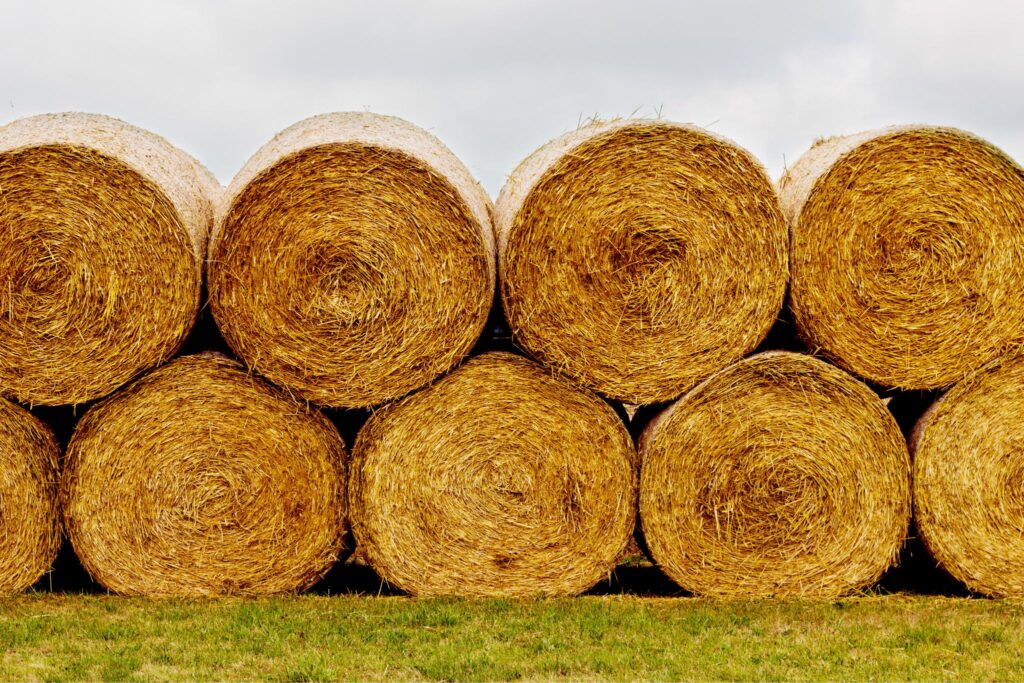
Source: Canva
Large Square Bales
A large square bale of hay is often referred to as a three-string bale. These bales measure around 16” high x 22” wide x 44” and weigh around 100 lbs.
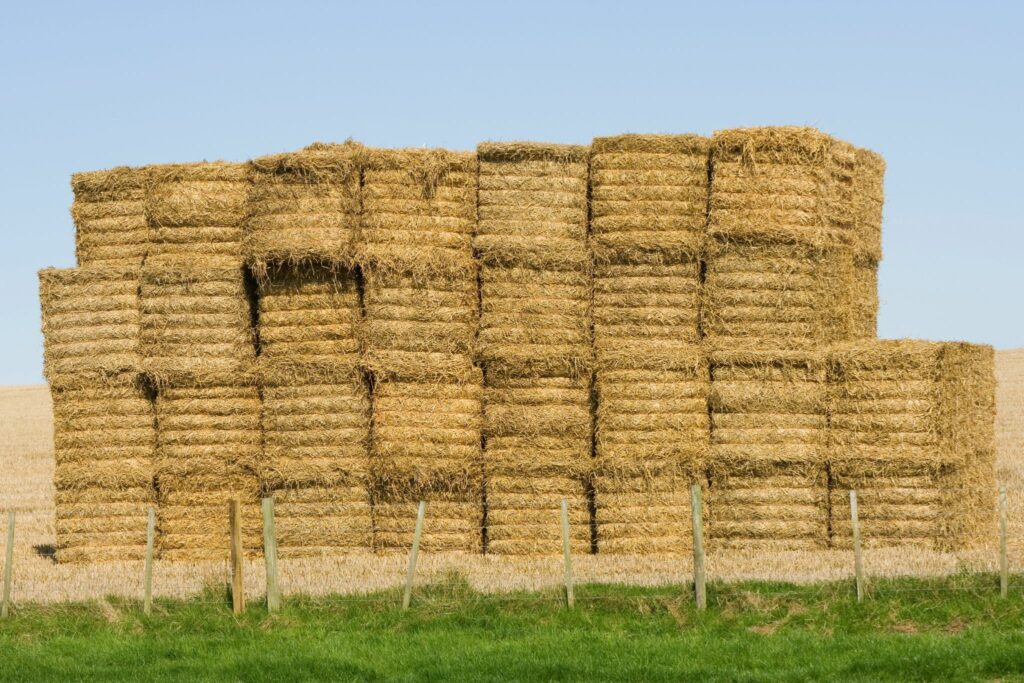
Source: Canva
Small Square Bales
Small square bales are ideal if you just have one or two horses, as they require less storage space and are light enough to be carried by hand.
A standard sized small square bale, or two-string bale, weighs between 50 and 60 lb and measures 14” high x 18” wide x 35” long.

Source: Canva
Hay Bundle
A bundle of hay consists of 21 small square bales. In some areas, you’ll need to purchase small bales in bundles—they won’t be sold individually.
Hay Types
Alfalfa
One the most popular types of hay for horses, because it is more nutrient dense, and higher in calories, calcium, and energy than other types of non-legume hay.
This makes it suitable for younger horses that are still growing, pregnant mares, and senior horses requiring more nutrition.
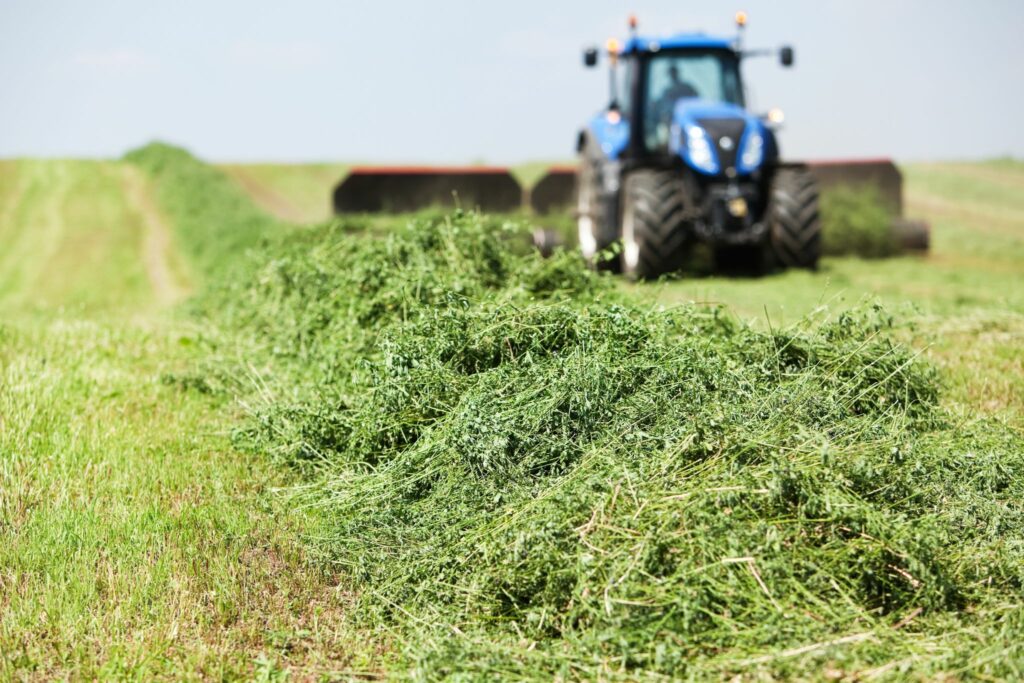
Source: Canva
For more sedentary adult horses, however, alfalfa can be too rich and may cause weight gain if fed as the only source of forage.
Grasses
- Orchard Grass – Orchard grass is widely available in the US and one of the highest quality grass hays you’re likely to come across. It contains the same levels of essential minerals as Timothy grass, but has a higher protein content (10-12%).
- Teff Grass – Teff grass contains less protein and fewer calories than other grass hays, making it ideal for horses with lower energy requirements and those susceptible to metabolic conditions.
- Timothy Grass – Finally, Timothy grass is highly digestible and a good source of fiber. It contains fewer calories and less protein than either Orchard grass or Alfalfa, which means it is suitable for obese and protein-sensitive horses.
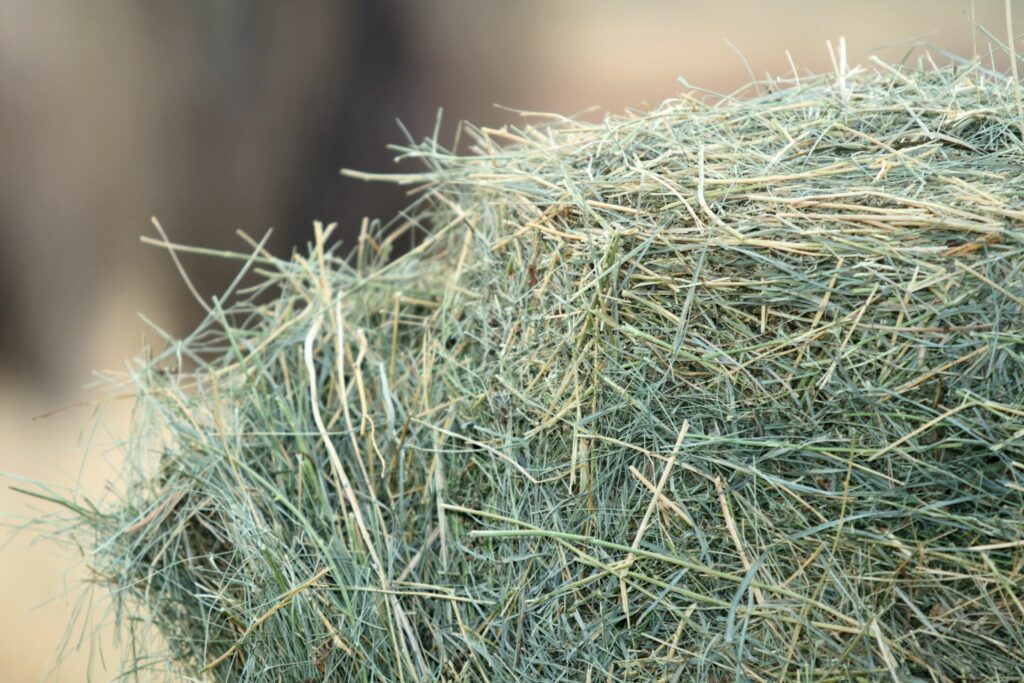
Source: Canva
Straw
While straw is more commonly used as bedding, rather than feed, some types of straw, like oat or barley straw, can be fed to horses as part of their daily roughage.
Regardless, it should only be fed in moderation due to its poor nutrient profile, and the increased risk of impaction colic.
Bagged Hay
If you don’t want to buy hay bales, you could always opt for bagged hay instead.
Bagged hay is chopped prior to packaging, and may contain a blend of different grasses, and additional supplements like canola oil.
These bales will be extremely uniform in nutrient profile, high quality, and relatively easy (comparatively) to handle. They are also very expensive!
Triple Crown offers a lineup of bagged forage in addition to grain.
- Hay Pellets – To make hay pellets, the grass is first dried, then ground into a powder, and then processed into pellets using a combination of heat and steam.
- Hay Cubes – Similar to bagged hay, hay cubes are made from hay that’s been chopped into smaller pieces and then mixed with water and natural binding agent, like bentonite.
This article sheds more light on the differences between cubes and pellets.
Now that we know exact what we’re buying, let’s find out how much hay costs…
| In Florida? | $10 – $13 |
| In Ohio? | $5 – $8 |
| In Colorado? | $8 – $15 |
| In New York? | $5 – 8 |
| In California? | $7 – $12 |
Keep in mind, hay prices can fluctuate quite considerably depending on a variety of factors. Droughts can create regional hay shortages, driving up prices. Also, states with short summers aren’t able to get as many cuttings, resulting in a more limited supply and therefore higher prices.
Hay supply can vary quite a bit state-to-state, too.
For example, hay prices in the Western USA, where summers are dry and short, tend to be more expensive than in the Midwest where water is abundant and warmer temperatures last longer.
Three cuttings per year is pretty typical, however in states like California, with more moderate year-round temperatures, farmers may be able to get five cuttings a year per field.
In most areas, alfalfa is considered to be more premium than grass hay and is more expensive. There are exceptions, however. For example, in Northern Colorado, alfalfa is more readily available and therefore tends to be a little less expensive than grass hay.
Hay Supply and Demand
Hay stocks dropped in the USA this year, largely due to increasing production costs and poor rains.
Although demand remains high, it has dropped in some states due to a decline in livestock farming.
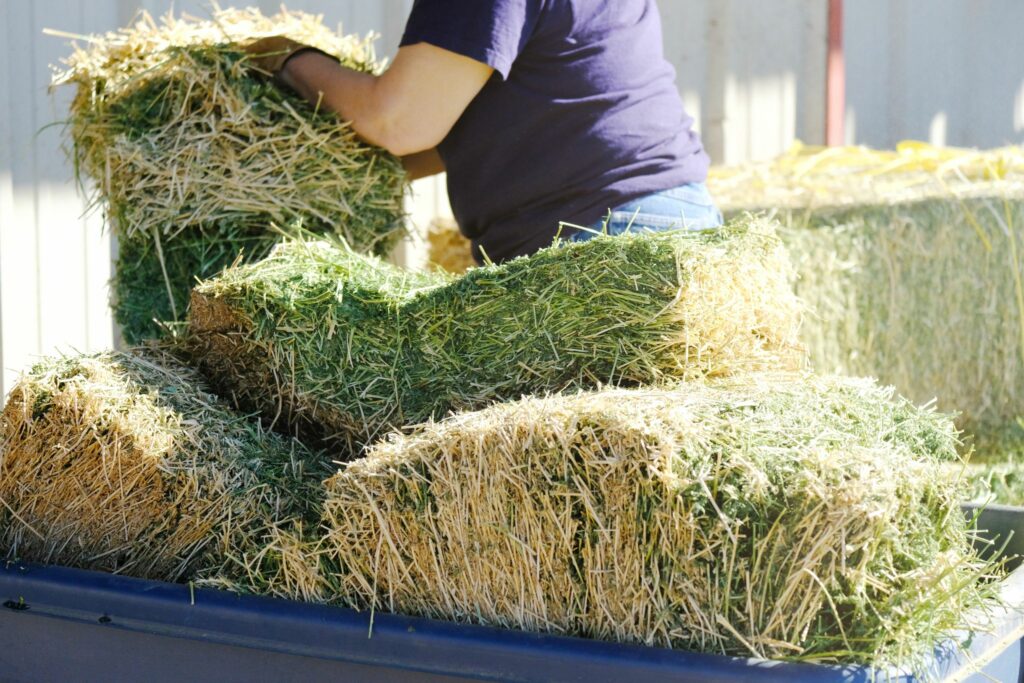
Source: Canva
Frequently Asked Questions
Q: How much does 1 bale hay cover?
If you’re using hay as mulch in your garden, a standard square bale covers around 80 sq. ft if spread at a depth of approximately three inches.
Q: How big is a 50 lb bale of hay?
A 50 lb bale of hay will usually measure 35” long, by 14” high, and 18” wide.
Q: Which is cheaper, hay or straw?
Straw is generally cheaper than hay, with small bales costing between $4 and $7, and large round bales around $40.
Q: How big is a full bale of hay?
A full (small, square) bale of hay weighs between 50 and 60 lb, and measures 35” long, by 14” high, and 18” wide.
Q: How much is a bale of hay at Tractor Supply?
Tractor Supply sells two-string bales of Bermuda hay for $14.99, and higher quality compressed hay at between $26.49 to $29.29 for 50 lb grab-and-go bags.
Q: How much is a bale of hay at Home Depot?
Home Depot doesn’t sell hay, but will sometimes sell straw bales.
Q: How much does a bale of hay weigh?
A standard sized bale of hay weighs between 50 and 60 lb, whereas a medium-sized round bale weighs between 700 and 900 lbs.
Q: How much is a bale of hay for horses?
A horse needs to eat between 1 and 2% of its body weight in roughage every day, so a 1,000 lb horse will consume between 10 and 20 lb of hay a day, meaning that a 50 lb bale will last between 2.5 and 5 days.
Parting Thoughts
When buying hay, you need to put your horse’s needs first, and your wallet second. Alfalfa is the best for hard keepers, but may also be more expensive. Grass hay like Orchard and Timothy, are suitable for horses that keep weight on easily, and Teff hay is best for horses with metabolic conditions.
It might be tempting to look around for the cheapest hay bales, but these are unlikely to give your horse the nutrition he requires to maintain his weight and energy levels, which is why you should always prioritize quality over quantity.
Check out our article on Horse Hay FAQs for more information about the different types of hay, and which would be best for your horse.
P.S. Enjoy this article? Trot on over to:
- Stability and Safety: How to Stack Hay Bales
- Horse Hay FAQs (Types of Hay and How to Feed It)
- Winter Hay 101: How Much to Feed Your Horse (And Why)
- How to Soak Hay for Horses (And Why Bother!)
- Winter Hay Feeding Quiz
- Happy Trails Gear Guide: What to Wear Horseback Trail Riding
- Daily Horse Care Made Simple (Quick-Print Checklist)
Source:
https://www.hpj.com/markets/state-b...cle_937eb827-b9ec-5736-b298-dd30d269b815.html
The post Hay Bale Facts and Figures (Sizes, Types, Costs) appeared first on Horse Rookie.
Continue reading...
